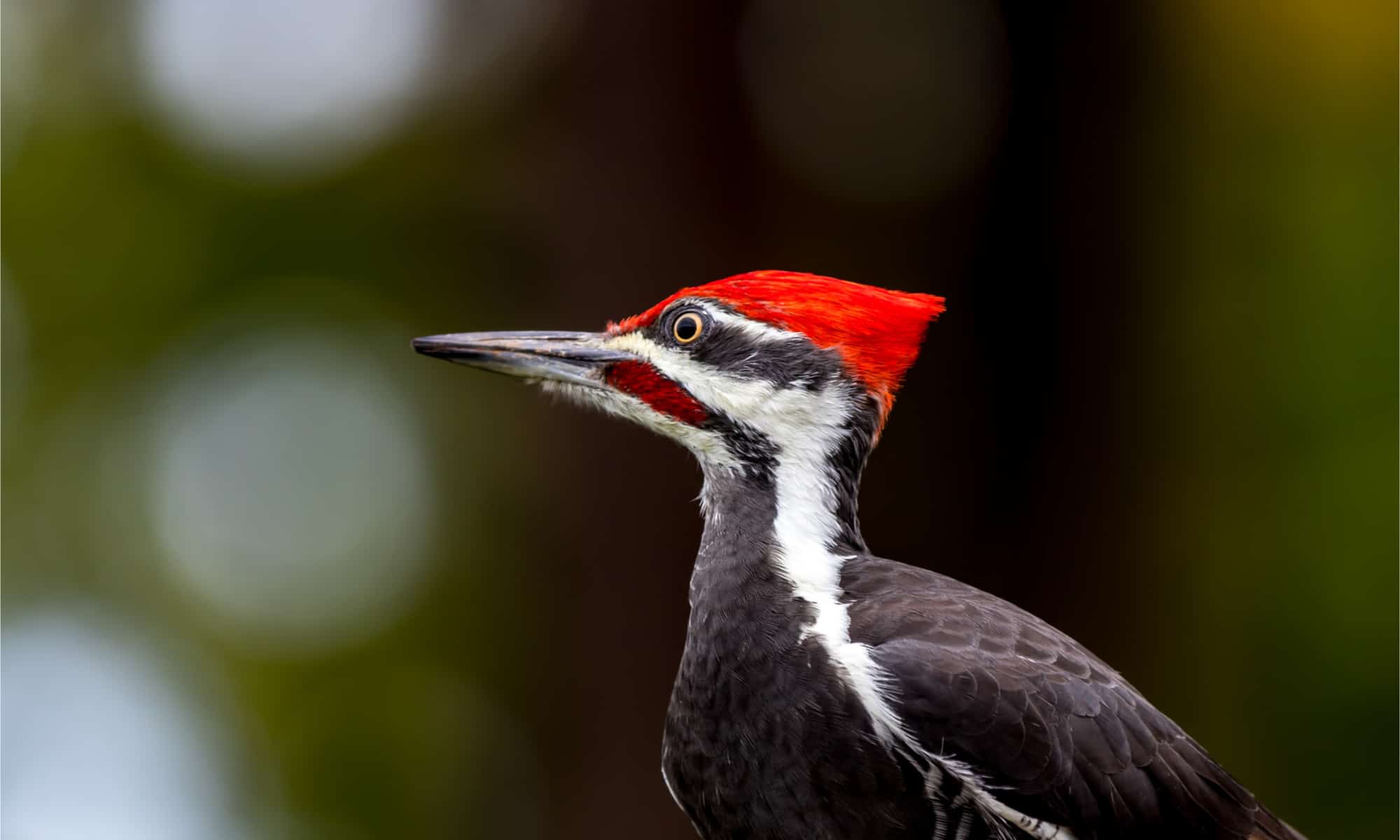If you walk through the woods, you may well see holes drilled into old trees or a hear a distant knocking sound. These are sure signs of woodpeckers in the vicinity. And like most states in the country, Alabama welcomes a rich diversity of bird species all year round. In the case of woodpeckers in Alabama, nine distinctive species exist here, though one is an occasional visitor, not native.
Let’s take a look at these nine gorgeous birds and learn how to identify them and where they might pop up in Alabama.
How to Attract Woodpeckers to Your Backyard
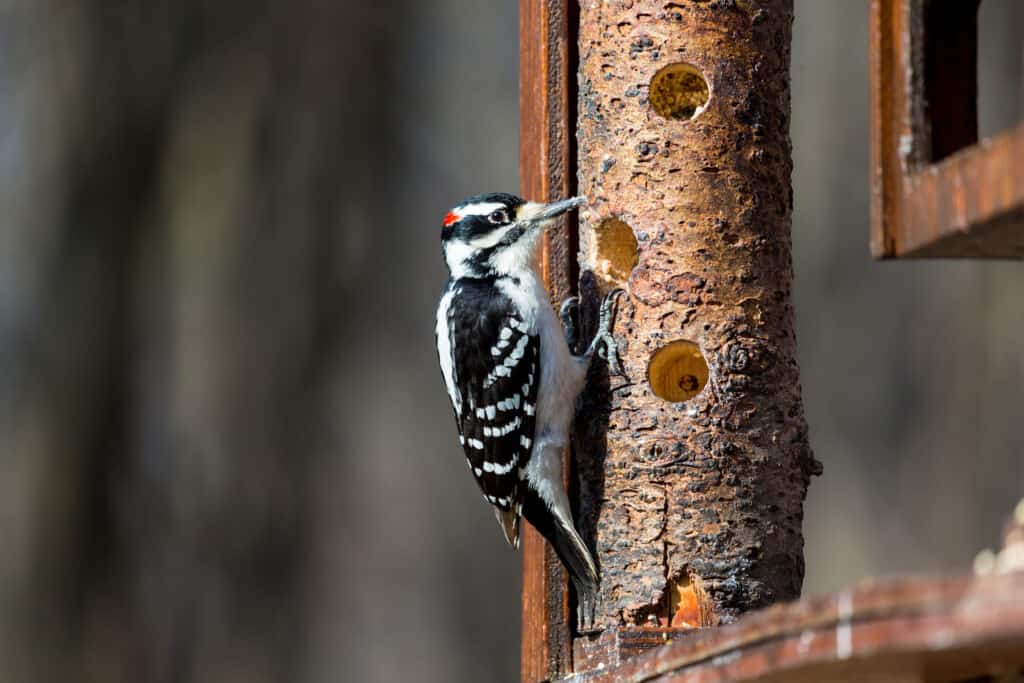
Downy woodpeckers and eight other species of woodpeckers in Alabama could be attracted to your backyard. Offer plenty of dead wood, feeders, native fruiting plants, and a water feature for the most birds ever!
©Glass and Nature/Shutterstock.com
Many folks love woodpeckers in Alabama and wish to see them more often. The best way to do this is prepare your backyard and garden to encourage a visit. These tips will help draw nature’s drills on wings to your home.
- Leave dead wood alone. Woodpeckers love drilling on old, dead trees, to draw out insects for their meals.
- Provide woodpecker food. That is, give them suet and black sunflower seeds. These are their favorites for keeping healthy all year-round.
- Plant native fruit bearing plants and trees. Woodpeckers love dogwood, tupelo, mountain strawberries, apples, mulberries, elderberries, and other natives.
- Add a water feature. Woodpeckers need water and enjoy a good birdbath, too.
- Put up some nesting boxes. Woodpeckers frequently use these, particularly pileated woodpeckers, for brooding and rest.
Where to Look for Woodpeckers in Alabama
Birdwatchers love spotting woodpeckers in the many terrains of Alabama. And while you could well spot them in your backyard, some locations are particularly well-suited to some species better than others.
- Bankhead National Forest
- Wheeler National Wildlife Refuge
- Mobile-Tensaw Delta
- Talladega National Forest
- Coosa Wildlife Management Area
- Locus Mountains
Bring along binoculars for a better chance of spotting the birds and affirmatively identifying them.
Red-bellied Woodpecker
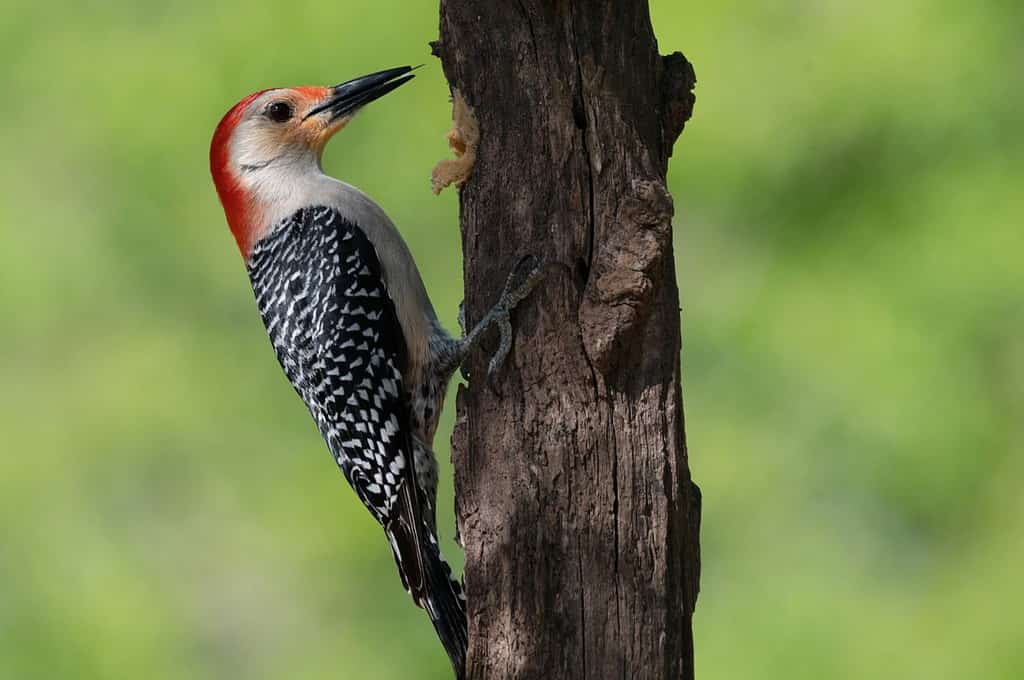
Red-bellied woodpeckers thrive in Alabama! They love the deadwood in the forests, and adore suet and peanuts in your yard. To see these beauties, make your own
peanut butter bird feeder ornaments.
©Connie Moore/Shutterstock.com
- Scientific name: Melanerpes carolinus
- Order: Piciformes
- Family: Picidae
- Size: 9.4 inches
- Loves: suet, peanuts, peanut butter
One of the most common woodpeckers in Alabama, the red-bellied woodpecker frequently visits backyards. They don’t drum all year, though, like some species. Instead, they do so during mating season when they’re looking for mates. This species has a red belly, red crown, and bar-coated feathers. The front and face tend to be brown. The medium-sized bird tends to be loud, pecks at siding, and often damages cedar shingles. Their distinctive call also helps folks identify them.
Red-bellied woodpeckers commonly hangout in the southeast, from Texas to Florida, and love visiting backyard feeders and using nesting boxes. They don’t migrate particularly but they will steel other birds’ nesting spots. You’ll find their nests in dead trees, with 4 to 5 eggs in them, on top of wood chips.
This species of woodpecker in Alabama devours spiders, grass seeds, fruit, nuts, and insects. They play an important role in dispersing oak and beech tree seeds in particular.
Hairy Woodpecker
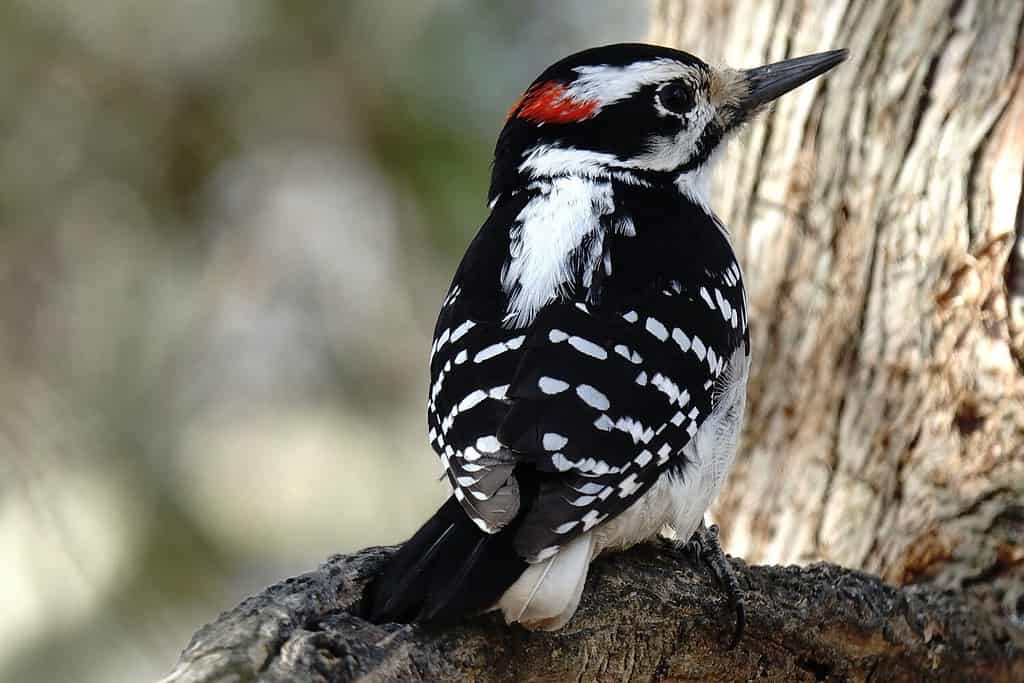
Hairy woodpeckers look like their name suggests. Hairy! The feathers have a sort of hairy look around their faces in particular. These adorable birds may be found all over Alabama.
©Carl Reader/Shutterstock.com
- Scientific name: Leuconotopicus villosus
- Order: Piciformes
- Family: Picidae
- Size: 7.1 to 10.2 inches
- Loves: trees full of insects
One of the most common woodpeckers in America, the hairy woodpecker loves Alabama backyards. These birds seek out trees with loads of insects in them, as this their main food source. The birds eared their common name through the sort of “hairy” appearance of their feathers. They’re small, drill loudly and frequently, and love sap and insects from holes drilled by other birds, too.
Hairy woodpeckers have long, pointed bills, black and white feather coloring, white chest, and speckled wings. They are smaller than Downy woodpeckers and have longer bills, but otherwise are frequently mistaken for each other.
Typically found amongst conifers, hairy woodpeckers may be found just about anywhere in the United States. They thrive in both warm and cool weather climates, making them perfect for the diverse climate of Alabama. They make their nests in trees and lay between 3 and 6 eggs each brood.
Northern Flicker

Even female northern flickers have the bright yellow coloring. These woodpeckers in Alabama thrive in most parts of the state.
©iStock.com/Irving A Gaffney
- Scientific name: Colaptes auratus
- Order: Piciformes
- Family: Picidae
- Size: 11.0 to 12.2 inches
- Loves: ground insects, especially ants
Despite their common name, northern flickers are also woodpeckers you’ll find in Alabama. They go by a few other names, as well, including the Yellow Flicker or the Red-shafted Flicker. They’re a common bird and among one of the largest woodpecker species in United States. Sometimes, folks call these woodpeckers in Alabama “yellowhammers.”
One difference with these birds is that Northern Flickers drum on the ground as they look for insects here instead of trees. They particularly love ants. They hop around while they eat, drumming away as they go. Then, they fly up to the treats to grab some fruit.
The coloration of Northern flickers may vary some, but mostly they have flecked tails and wings with black markings on their faces and crests. The coloration on their bodies may be yellow to red on their faces and wings, with brownish colors on their bodies.
Mostly, Northern flickers stick to the eastern end of the country, but occasionally may be spotted all the way up in Alaska. Overall, though, they’re quite common all over the United States. They have a wide range of calls, typically drumming in a more musical tone, along with gurgling calls. Their “wicka-wicka-wicka” cry ranges far and is often mistaken for that of the red-winged blackbird.
Pileated Woodpecker

The large pileated woodpecker shows off a stunning red crest and distinctive white stripes. These beauties thrive in Alabama and other southeastern states.
©MasterShopArt/Shutterstock.com
- Scientific name: Dryocopus pileatus
- Order: Piciformes
- Family: Picidae
- Size: 15.8 to 19.3 inches
- Loves: carpenter ants
Once thought to be extinct by unknowledgeable enthusiasts, the Pileated Woodpecker has made a strong comeback and become a regular resident in Alabama. Some of the confusion may have come because the Ivory-billed woodpecker was also believed to be extinct and looks similar to the pileated.
Among the largest woodpecker species of the world, the pileated frequently enjoys the wooded areas of Alabama and may be heard tapping on the wood. The large bird stands as tall as 19.3 inches, with a large red crown and monochromatic body. They have long legs, thin beaks, and males have facial markings that look a bit like a mustache.
Pileated woodpeckers leave behind large rectangular holes when they hammer away at trees. Here, they find ants and other insects to dine on before leaving the holes for animal shelters. They have loud cries of high-pitched piping calls.
Pileated woodpeckers range across the eastern United States, up into Nova Scotia, and occasionally wandering as far west as California.
Red-cockaded Woodpecker

The red-cockaded woodpecker is the rarest woodpecker in America. Despite its name, though, there’s rarely much red on the bird.
©feathercollector/ via Getty Images
- Scientific name: Dryobates borealis
- Order: Piciformes
- Family: Picidae
- Size: 7.9 to 9.1 inches
- Loves:fruits, seeds, and insects
The rarer red-cockaded woodpecker may also be spotted in Alabama, though not as frequently as downy or hairy woodpeckers. These birds generally won’t be found on dead trees like their cousins, but prefer pecking away at live plants and trees.
These much smaller woodpeckers are roughly the size of a robin, with fuzzy looking feathers. Their feathers are adorned with brown bars on the wings and tails, and their heads are marked with black and white markings. The males have tiny red markings on their chests.
Red-cockaded woodpeckers are considered endangered and have been since 1970. The birds live in family units that remain together for one year after birth. Then, the young males fly off to begin their own families.
The best place to spot these rare birds, of which only 15,000 still exist, head to the Talladega National Forest, Coosa Wildlife Management Area or the Locus Mountains.
Red-headed Woodpecker
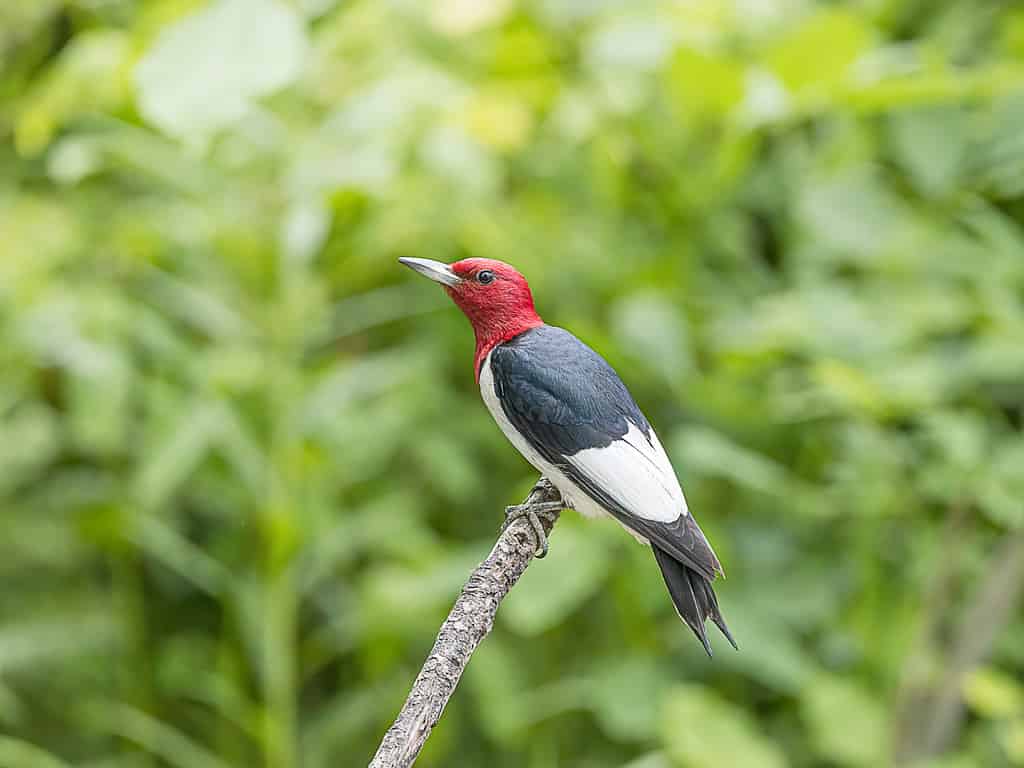
There are nine different woodpeckers in Alabama. The red-headed woodpecker is just one of the (mostly) black and white birds with red accents.
©ilkah/Shutterstock.com
- Scientific name: Melanerpes erythrocephalus
- Order: Piciformes
- Family: Picidae
- Size: 7.5 to 9.1 inches
- Loves:insects, fruits, seeds, suet, small birds
Another large species of woodpecker, the red-headed woodpecker may frequently be found drumming on trees in Alabama. The brightly colored birds don’t call out often, but you can definitely hear them working on the trees. Surprisingly, though, this bird actually prefers catching other, smaller birds to catching insects.
Red-headed woodpeckers have bright red crowns on their red heads, with white bodies, and monochrome winds and tails. These birds prefer the eastern states and may range into Canada, Florida, and as far west as New Mexico on occasion.
Males of the red-headed species choose the nesting site and helps the female build the nest. Typically, two broods each year produce between three and ten eggs each. It only takes 12 to 14 days to incubate the eggs, and only 24 to 31 days before the fledglings are ready to leave the nest.
The aggressive birds will fight other birds, including larger birds like ducks, for nesting boxes, so watch out! They also like dead trees for nesting.
Downy Woodpecker

While they look similar to hairy woodpeckers, downy woodpeckers are actually different birds. Both species thrive in Alabama, though, so you could easily mistake them for each other!
©J Edwards Photography/Shutterstock.com
- Scientific name: Dryobates pubescens
- Order: Piciformes
- Family: Picidae
- Size: 5.5 to 6.7 inches
- Loves:tree sap and insects, fruits, weeds, seeds
The smallest woodpeckers in Alabama, and the smallest native in America, the downy woodpecker lives up to its name with its adorable fluffy feathers. These birds prefer milder climates, like that found in Alabama, but occasionally travel elsewhere in the country.
They emit sharp, bright calls and love to feed on seeds in backyard feeders. The birds have large black and white spots, with males bearing red dots on the backs of their heads. Stripes and spots bedeck their winds, making each bird distinct from another. They’re bigger than house finches but smaller than robins, with white bellies and mostly black wings.
Downy woodpeckers nest in dead or living trees that have dead zones. They peck into the wood to create cavities large enough for the nests and themselves, and no more. Lining the nests with only wood chips, the birds take weeks to create the nest, both males and females working at it. They birth one brood each year, with three to eight eggs each.
Yellow-bellied Sapsucker

Yellow-belly sapsuckers are omnivores, and like their namesake, sapsuckers eat, live, and breathe sap. And despite their name, they are actually one of the nine species of woodpeckers in Alabama.
©Glass and Nature/Shutterstock.com
- Scientific name: Sphyrapicus varius
- Order: Piciformes
- Family: Picidae
- Size: 7.1 to 8.7 inches
- Loves:tree sap and suet
Despite the name, yellow-bellied sapsuckers also belong to the woodpecker family. They mostly nosh on sap, earning their name, and love that suet you put out for them. They drill holes in trees looking for the sap in staggered pecking patterns. Their nests are usually as high as they can get them.
Yellow-bellied sapsuckers have yellow bellies, as the name suggests. They also usually have reddish crowns and throats, with black and white bars and flecks on their wings, bodies, and tails. They are larger than downy woodpeckers but smaller than hairy woodpeckers. They have straight bills, long wings, and often a red throat.
These birds are known as the most migratory woodpeckers in the world. They breed as far north as Arkansas and winter as far south as Panama or the Caribbean. They prefer forests but may migrate to central plains and mountains.
Ivory-billed Woodpecker
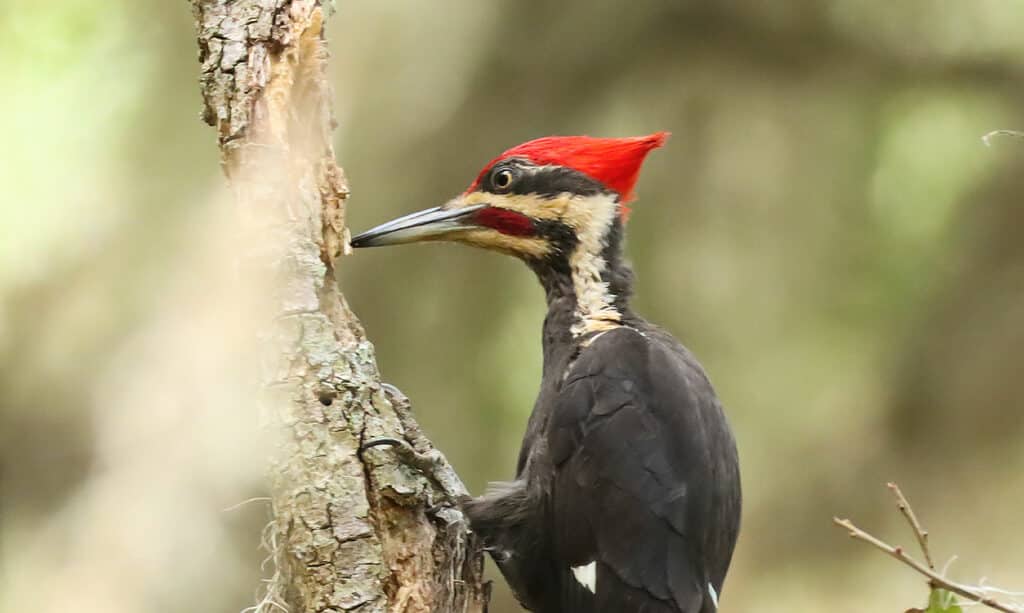
Looking remarkably similar to pileated woodpeckers, ivory-billed woodpeckers are rare. Folks often confuse the two birds and have thought both were extinct. However, it is just the
ivory-billed woodpecker
that was officially considered gone forever. Thankfully, though, the bird has made a come-back and several have been seen in recent years.
©iStock.com/Wirestock
- Scientific name: Campephilus principalis
- Order: Piciformes
- Family: Picidae
- Size: 18 to 20 inches
- Loves:beetle larvae
Accidental woodpeckers in Alabama, Ivory-billed woodpeckers were thought to be extinct. They rarely make their way to Alabama, but when they do, they cause quite a stir! The endangered birds do not migrate and generally live in Arkansas, Louisiana, and Florida. When they make their way into Alabama, it’s always a surprise, since only three sightings officially stand on record.
The bird was once common in Alabama before the Civil War, but populations were hunted into extinction and endangered status. The ivory-billed woodpecker remains the largest woodpecker species in North America and only resides within the southeast.
These beautiful birds are mostly black, with two distinctive white stripes running down the sides of their necks and backs. Males have ivory bills and large red crests, while females have black crests. Folks often mistake them for pileated woodpeckers. Females lay between one and five eggs per clutch and both parents take care of the nest while they incubate for three weeks.
Thank you for reading! Have some feedback for us? Contact the AZ Animals editorial team.

